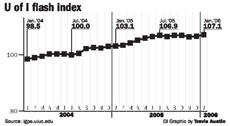Illinois’ economic index increases

Online Poster
Feb 15, 2006
Last updated on May 12, 2016 at 01:13 a.m.
The state of Illinois’ Flash Index rose to 107.1 for its most current reading in January, up from 106.6 in December.
The index, which gives an instantaneous measurement of the performance of Illinois’ economy, was developed by University economics professor J. Fred Giertz and former professor John Crihfield.
“If it captures what it’s supposed to capture, it means the Illinois economy is doing well right now, especially compared to the rest of the country,” Giertz said. “The rest of the country is still expanding but it is not expanding quite as rapidly as it was about a half a year ago or so.”
The reading is the highest in Illinois since the 2001 recession. It is also the highest reading in eight years, matching 1998.
Get The Daily Illini in your inbox!
Using data from the Illinois Department of Revenue, the Flash index employs three criteria to determine the economy’s performance: personal income, business profits and retail sales. Individual income tax receipts reflect personal income, corporate receipts are used for business profits, and sales tax receipts measure retail sales. The index is based off of six months of data. With each new reading, the new month is added to the data while the oldest month is dropped.
All three aspects of the index, expressed in real terms to reflect only changes in the economy, rose in January. Corporate tax receipts saw the greatest gains when compared to amounts at the same time a year earlier.
The benefit of the Flash index is its immediacy. Other economic indicators rely on data that takes time to release, while Flash gives a current picture of the economy.
Giertz said the current reading indicates an expanding Illinois economy. Readings below 100 show a contracting economy.
Geoffrey Hewings, professor of economics who created another economic index for the city of Chicago, said there is an inconsistency between the generally positive feelings of Illinois’ economy and the state’s troubling labor market. He said in the manufacturing sector there have been issues of “skills mismatch.” This means that there are jobs available, but no one to fill them because they lack the proper skills or training to be eligible.
“The biggest gap has been in job growth,” Hewings said.
Using data from his Chicago Business Activity Index, Hewings said Chicago experienced drops in employment in 2005. However, he said Chicago is still the “engine in the Illinois economy.” He said 52,000 of the 61,300 new jobs for Illinois in 2005 came from Chicago.
Despite its value, the index is not a decision-making tool. Hewings said indices such as Flash simply give a “heads up” as to what direction the economy is headed. Giertz added that the index is simply an idea of what the economy is doing. This is because computing the index is both an “art and a science,” and requires some subjective judgment, he said.
“It requires not just putting the numbers into the computer but making some adjustments before that as well,” Giertz said.
For instance, he said that if Illinois were to get large amounts of taxes from a legal settlement, that amount would not reflect economic changes and therefore would not be included in the measurement.
While tax measures may not exactly reflect happenings in the economy and may require some subjective judgment, Giertz said the Flash index remains a valuable information source because of its immediacy.
“It can be used to see what’s going on in the economy and maybe make some predictions about the future,” Giertz said. “It also could be a kind of a flag; if suddenly there’s a big downturn, it may indicate there’s a problem brewing that might not be seen otherwise.”





